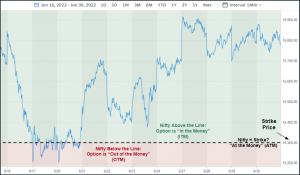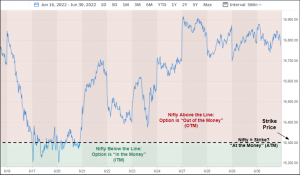Chapter 2
It’s all about the Money(ness)!
When you first start reading about trading options, you will undoubtedly come across the term ‘moneyness’. You may also see terms like ‘in-the-money’ or ‘out-of-the-money’. While this may seem technical, it is a straightforward concept.
To understand the concept of Moneyness, let’s go back to school! Remember exams? And those dreaded days when you got back your results? Unless you were among the class nerds, you probably first checked to see if you had passed.
- If you had scored 35%, you had scraped through or ‘just passed’.
- If you scored over 35%, you congratulated yourself on a job well done.
- Had you unfortunately scored below 35%, well, you prepared yourself to face the music at home - because you had failed.
Right? Moneyness is very similar. Let’s understand this with an example.
Moneyness in Call Options
Assume that you purchased a call option on the Nifty50 with a strike price of 15,300. You made this purchase on 16 June 2022 and this option expires on 30 June 2022. Over this two-week period, the Nifty will move up, down, and sideways. Depending on where the Nifty’s price is at will determine the intrinsic value or ‘moneyness’ of this call option. The following three scenarios are possible -
- If the underlying price is equal to an option’s strike price, the option is said to be ‘at the money’. In this example, when the Nifty is at 15,300, our call option with a strike of 15,300 will be at the money.
Consider the strike price like your 35% limit. So, being ‘at the money’ is like scoring exactly 35%, or where you have just passed the exam.
- A call option is described as ‘in-the-money’ if the underlying price is above the option’s strike price. As a reminder, a call option provides the owner the right to buy the underlying security at the strike price. The age-old adage of trading is: buy low, sell high. So, the situation is favourable if you can sell the underlying higher than what you can buy it at (strike price). This represents being in-the-money (or the option has intrinsic value).
To relate back to our school results example, being ‘in-the-money’ is like scoring above 35%.
- Alternatively, a call option is described as ‘out-of-the-money’ if the underlying price is below the option’s strike price.
You don’t need a genius to tell you that this situation is similar to scoring below 35%, or failing the exam.
Let’s look at a visual representation of the above example. In the chart below, we have provided the Nifty daily closing prices for this two-week period. We have added a dividing line at the price of 15,300 - the option’s strike price in our example.
- Any time the Nifty’s price is above that line, as shown in the shaded green section, our option is in-the-money. The term ‘in-the-money’ is often abbreviated as ITM.
- Any time the Nifty’s price is below that line, as shown in the shaded red section, our option is out-of-the-money. The term ‘out-of-the-money’ is often abbreviated as OTM.
Illustration 1: Call Option Moneyness Example

Do note here, that you cannot apply the ‘35% or fail’ concept to Put options. We will use a different example to understand that better.
Moneyness in Put Options
As we have discussed previously, put options often follow a pattern opposite to call options. We have plotted a second chart below that also shows the Nifty daily closing prices for the same two-week period. This chart also has the dividing line at the example strike price of 15,300. However, let’s assume that instead of purchasing a call option, we instead decided to purchase a put option on 16 June 2022.
With put options, what defines moneyness is reversed. A put option gives the owner the right to sell the underlying security at the strike price. Thus , you would want to sell high and buy low, rather than buy low and sell high.
Here is a quick example to explain this better:
Let’s say you own a laptop that you currently don’t need. Perhaps over the last several months, the price of new and used laptops have gone up significantly due to microchip shortages. You are able to sell your laptop at nearly the price you paid for it when it was new. Maybe in a year, you realise that you still need that laptop.
During this time, the microchip supply chain has sorted itself out and prices of new and used laptops have dropped dramatically. You are now able to buy back a comparable laptop at a fraction of what you sold it for, thus netting a small profit.
With this in mind, let’s look at our chart and the possible scenarios.
- When the Nifty’s price is below our example strike price of 15,300, the put option is in-the-money (ITM). This is shown by the shaded green section in our chart below.
- On the other hand, when the Nifty’s price is above the strike price of 15,300, the put option is out-of-the-money (OTM).
Illustration 2: Put Option Moneyness Example

To Conclude
- Moneyness describes the intrinsic value of an option.
- If the option has intrinsic value, it is in-the-money or if an option is in-the-money, the option has intrinsic value.
- If an option is out-of-the-money, the option has no intrinsic value.
- For call options, we showed that if the underlying stock or index price was currently above the strike price of the option that you purchased, then this call option has intrinsic value.
- If we owned a put option and the underlying stock or index price was currently below the strike price of the option that was purchased, then this put option has intrinsic value.
You may wonder, if an option has no intrinsic value, can I buy it for free? Unfortunately, it doesn’t work that way because options can have both intrinsic value as well as ‘time value’.
We will discuss what Open Interest means in our next chapter.

Test your OQ (Options Quotient)
Take your first step towards financial independence with the right training.



